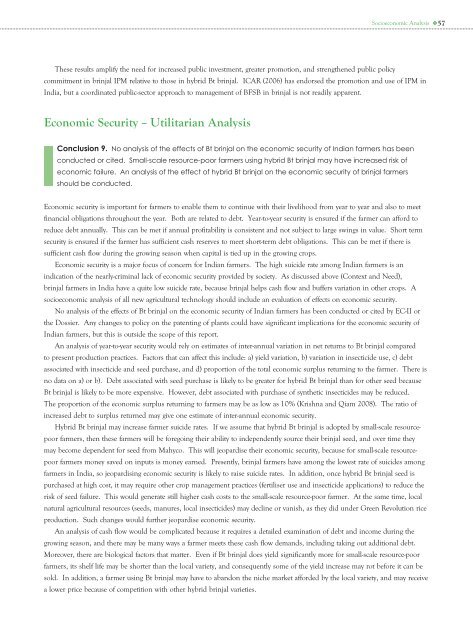Bt Brinjal The scope and adequacy of the GEAC environmental risk assessment
Bt Brinjal: The scope and adequacy of the GEAC ... - Down To Earth
Bt Brinjal: The scope and adequacy of the GEAC ... - Down To Earth
- No tags were found...
Create successful ePaper yourself
Turn your PDF publications into a flip-book with our unique Google optimized e-Paper software.
Socioeconomic Analysis 57<strong>The</strong>se results amplify <strong>the</strong> need for increased public investment, greater promotion, <strong>and</strong> streng<strong>the</strong>ned public policycommitment in brinjal IPM relative to those in hybrid <strong>Bt</strong> brinjal. ICAR (2006) has endorsed <strong>the</strong> promotion <strong>and</strong> use <strong>of</strong> IPM inIndia, but a coordinated public-sector approach to management <strong>of</strong> BFSB in brinjal is not readily apparent.Economic Security – Utilitarian AnalysisConclusion 9. No analysis <strong>of</strong> <strong>the</strong> effects <strong>of</strong> <strong>Bt</strong> brinjal on <strong>the</strong> economic security <strong>of</strong> Indian farmers has beenconducted or cited. Small-scale resource-poor farmers using hybrid <strong>Bt</strong> brinjal may have increased <strong>risk</strong> <strong>of</strong>economic failure. An analysis <strong>of</strong> <strong>the</strong> effect <strong>of</strong> hybrid <strong>Bt</strong> brinjal on <strong>the</strong> economic security <strong>of</strong> brinjal farmersshould be conducted.Economic security is important for farmers to enable <strong>the</strong>m to continue with <strong>the</strong>ir livelihood from year to year <strong>and</strong> also to meetfinancial obligations throughout <strong>the</strong> year. Both are related to debt. Year-to-year security is ensured if <strong>the</strong> farmer can afford toreduce debt annually. This can be met if annual pr<strong>of</strong>itability is consistent <strong>and</strong> not subject to large swings in value. Short termsecurity is ensured if <strong>the</strong> farmer has sufficient cash reserves to meet short-term debt obligations. This can be met if <strong>the</strong>re issufficient cash flow during <strong>the</strong> growing season when capital is tied up in <strong>the</strong> growing crops.Economic security is a major focus <strong>of</strong> concern for Indian farmers. <strong>The</strong> high suicide rate among Indian farmers is anindication <strong>of</strong> <strong>the</strong> nearly-criminal lack <strong>of</strong> economic security provided by society. As discussed above (Context <strong>and</strong> Need),brinjal farmers in India have a quite low suicide rate, because brinjal helps cash flow <strong>and</strong> buffers variation in o<strong>the</strong>r crops. Asocioeconomic analysis <strong>of</strong> all new agricultural technology should include an evaluation <strong>of</strong> effects on economic security.No analysis <strong>of</strong> <strong>the</strong> effects <strong>of</strong> <strong>Bt</strong> brinjal on <strong>the</strong> economic security <strong>of</strong> Indian farmers has been conducted or cited by EC-II or<strong>the</strong> Dossier. Any changes to policy on <strong>the</strong> patenting <strong>of</strong> plants could have significant implications for <strong>the</strong> economic security <strong>of</strong>Indian farmers, but this is outside <strong>the</strong> <strong>scope</strong> <strong>of</strong> this report.An analysis <strong>of</strong> year-to-year security would rely on estimates <strong>of</strong> inter-annual variation in net returns to <strong>Bt</strong> brinjal comparedto present production practices. Factors that can affect this include: a) yield variation, b) variation in insecticide use, c) debtassociated with insecticide <strong>and</strong> seed purchase, <strong>and</strong> d) proportion <strong>of</strong> <strong>the</strong> total economic surplus returning to <strong>the</strong> farmer. <strong>The</strong>re isno data on a) or b). Debt associated with seed purchase is likely to be greater for hybrid <strong>Bt</strong> brinjal than for o<strong>the</strong>r seed because<strong>Bt</strong> brinjal is likely to be more expensive. However, debt associated with purchase <strong>of</strong> syn<strong>the</strong>tic insecticides may be reduced.<strong>The</strong> proportion <strong>of</strong> <strong>the</strong> economic surplus returning to farmers may be as low as 10% (Krishna <strong>and</strong> Qiam 2008). <strong>The</strong> ratio <strong>of</strong>increased debt to surplus returned may give one estimate <strong>of</strong> inter-annual economic security.Hybrid <strong>Bt</strong> brinjal may increase farmer suicide rates. If we assume that hybrid <strong>Bt</strong> brinjal is adopted by small-scale resourcepoorfarmers, <strong>the</strong>n <strong>the</strong>se farmers will be foregoing <strong>the</strong>ir ability to independently source <strong>the</strong>ir brinjal seed, <strong>and</strong> over time <strong>the</strong>ymay become dependent for seed from Mahyco. This will jeopardise <strong>the</strong>ir economic security, because for small-scale resourcepoorfarmers money saved on inputs is money earned. Presently, brinjal farmers have among <strong>the</strong> lowest rate <strong>of</strong> suicides amongfarmers in India, so jeopardising economic security is likely to raise suicide rates. In addition, once hybrid <strong>Bt</strong> brinjal seed ispurchased at high cost, it may require o<strong>the</strong>r crop management practices (fertiliser use <strong>and</strong> insecticide applications) to reduce <strong>the</strong><strong>risk</strong> <strong>of</strong> seed failure. This would generate still higher cash costs to <strong>the</strong> small-scale resource-poor farmer. At <strong>the</strong> same time, localnatural agricultural resources (seeds, manures, local insecticides) may decline or vanish, as <strong>the</strong>y did under Green Revolution riceproduction. Such changes would fur<strong>the</strong>r jeopardise economic security.An analysis <strong>of</strong> cash flow would be complicated because it requires a detailed examination <strong>of</strong> debt <strong>and</strong> income during <strong>the</strong>growing season, <strong>and</strong> <strong>the</strong>re may be many ways a farmer meets <strong>the</strong>se cash flow dem<strong>and</strong>s, including taking out additional debt.Moreover, <strong>the</strong>re are biological factors that matter. Even if <strong>Bt</strong> brinjal does yield significantly more for small-scale resource-poorfarmers, its shelf life may be shorter than <strong>the</strong> local variety, <strong>and</strong> consequently some <strong>of</strong> <strong>the</strong> yield increase may rot before it can besold. In addition, a farmer using <strong>Bt</strong> brinjal may have to ab<strong>and</strong>on <strong>the</strong> niche market afforded by <strong>the</strong> local variety, <strong>and</strong> may receivea lower price because <strong>of</strong> competition with o<strong>the</strong>r hybrid brinjal varieties.











